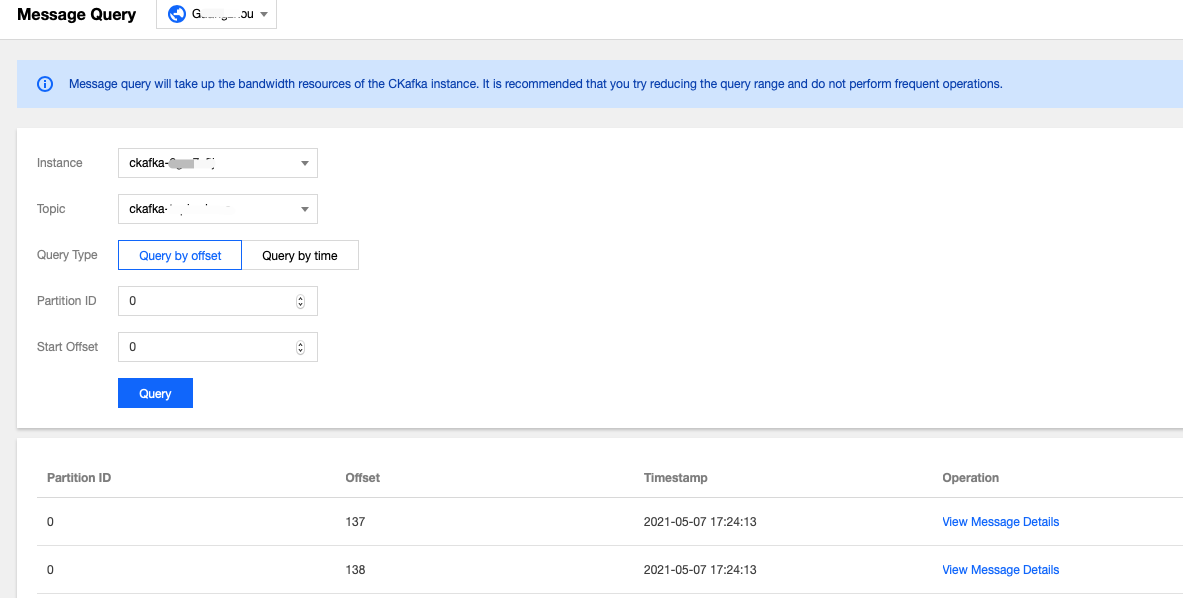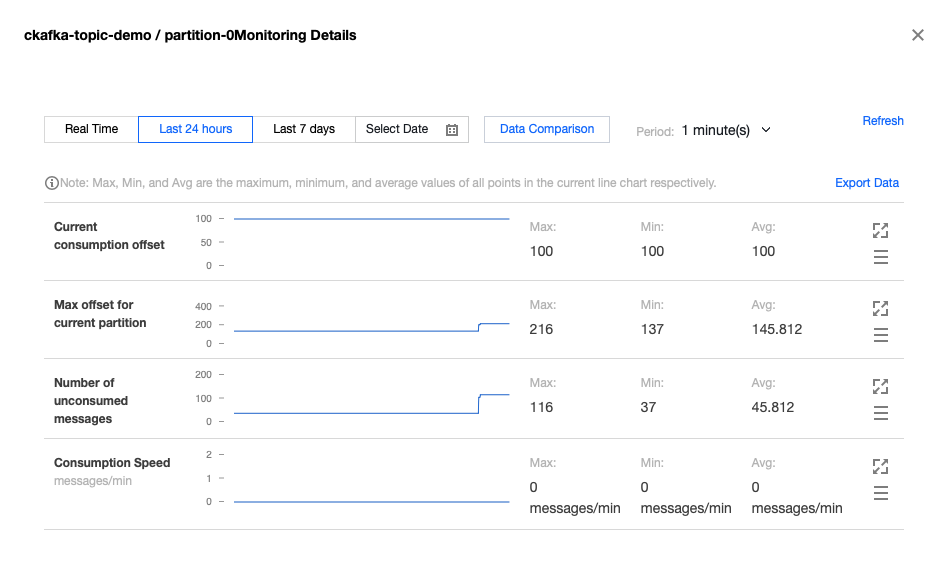TDMQ for CKafka
- Release Notes and Announcements
- Product Introduction
- Technical Principles
- High Availability
- Purchase Guide
- Billing Overview
- Getting Started
- Obtaining Access Permission
- VPC Access
- Step 4. Send/Receive Messages
- Access via Public Domain Name
- Step 5. Send/Receive Messages
- Development Guide
- Operation Guide
- Instance Management
- Topic Management
- Instance Topic
- Elastic Topic
- Consumer Group
- Monitoring and Alarms
- Smart Ops
- Permission Management
- Migration to Cloud
- CKafka Connector
- Task Management
- Creating Data Access Task
- Creating Data Distribution Task
- Simple Data Processing
- Practical Tutorial
- Practical Tutorial of CKafka Client
- Connector Practical Tutorial
- Reporting over HTTP
- Querying Subscription to Database Change Info
- Log Access
- Troubleshooting
- Topic Failures
- Consumer Group Failures
- Client Failures
- API Documentation
- Making API Requests
- DataHub APIs
- ACL APIs
- Topic APIs
- Instance APIs
- Other APIs
- SDK Documentation
- SDK for Java
- SDK for Python
- SDK for Node.js
- SDK for Connector
- Elastic Topic Message Sending and Receiving
- General References
- Connector
- Database Change Subscription
- FAQs
VPC Access Through SASL_SCRAM
Last updated: 2024-11-07 15:40:43
Overview
This document describes how to access CKafka to receive/send messages with the SDK for Java through SASL_SCRAM in a VPC.
Note:
SASL_SCRAM_256 (Supported only by instances of versions 1.1.1, 2.4.1, and 2.8.1. For existing instances, upgrade the broker minor version or submit a ticket for application.)
SASL_SCRAM_512 (Supported only by instances of versions 1.1.1, 2.4.1, and 2.8.1. For existing instances, upgrade the broker minor version or submit a ticket for application.)
Prerequisites
You have installed JDK 1.8 or later.
You have installed Maven 2.5 or later.
You have configured an ACL policy.
You have downloaded the demo.
Directions
Step 1. Create resources in the console
1. Create an access point.
1.1 On the Instance List page in the CKafka console, click the target instance ID to enter the instance details page.
1.2 In Basic Info > Access Mode, click Add a routing policy. In the pop-up window, configure the following items:
Route Type: Select "Public domain name access".
Access Mode: Select "SASL_SCRAM".

2. Create a role.
In ACL Policy Management > User Management, create a role and set the password.

3. Create a topic.
Step 2. Add the configuration file
1. Add the following Java dependent library information to the
pom.xml file:<dependencies><dependency><groupId>org.apache.kafka</groupId><artifactId>kafka-clients</artifactId><version>2.1.0</version></dependency><dependency><groupId>org.slf4j</groupId><artifactId>slf4j-api</artifactId><version>1.7.5</version></dependency><dependency><groupId>org.slf4j</groupId><artifactId>slf4j-simple</artifactId><version>1.6.4</version></dependency></dependencies>
2. Create a JAAS configuration file named
ckafka_client_jaas.conf and modify it with the user created in ACL Policy Management > User Management.KafkaClient {org.apache.kafka.common.security.plain.PlainLoginModule requiredusername="yourinstance#yourusername"password="yourpassword";};
Note:
Set
username to a value in the format of instance ID + # + configured username, and password to a configured password.3. Create a CKafka configuration file named
kafka.properties.## Configure the accessed network by copying the information in the **Network** column in the **Access Mode** section on the instance details page in the console.bootstrap.servers=xx.xx.xx.xx:xxxx## Configure the topic by copying the information on the **Topic Management** page in the consoletopic=XXX## Configure the consumer group as neededgroup.id=XXX## SASL Configurationjava.security.auth.login.config.plain=/xxxx/ckafka_client_jaas.conf
Parameter | Description |
bootstrap.servers | Accessed network, which can be copied in the Network column in the Access Mode section on the instance details page in the console.  |
topic | Topic name, which can be copied in Topic Management on the instance details page in the console.  |
group.id | You can customize it. After the demo runs successfully, you can see the consumer on the Consumer Group page. |
java.security.auth.login.config.plain | Enter the path of the JAAS configuration file ckafka_client_jaas.conf. |
4. Create the configuration file loading program
CKafkaConfigurer.java.public class CKafkaConfigurer {private static Properties properties;public static void configureSaslPlain() {// If you have used the `-D` parameter or another method to set the path, do not set it again here.if (null == System.getProperty("java.security.auth.login.config")) {// Replace `XXX` with your own pathSystem.setProperty("java.security.auth.login.config",getCKafkaProperties().getProperty("java.security.auth.login.config.plain"));}}public synchronized static Properties getCKafkaProperties() {if (null != properties) {return properties;}// Get the content of the configuration file `kafka.properties`.Properties kafkaProperties = new Properties();try {kafkaProperties.load(CKafkaProducerDemo.class.getClassLoader().getResourceAsStream("kafka.properties"));} catch (Exception e){System.out.println("getCKafkaProperties error");}properties = kafkaProperties;return kafkaProperties;}}
Step 3. Send messages
1. Create a message sending program named
KafkaSaslProducerDemo.java.public class KafkaSaslProducerDemo {public static void main(String[] args) {// Set the path of the JAAS configuration file.CKafkaConfigurer.configureSaslPlain();// Load `kafka.properties`.Properties kafkaProperties = CKafkaConfigurer.getCKafkaProperties();Properties props = new Properties();// Set the access point. Get the access point of the corresponding topic in the console.props.put(ProducerConfig.BOOTSTRAP_SERVERS_CONFIG,kafkaProperties.getProperty("bootstrap.servers"));//// Access through SASL_SCRAM//props.put(CommonClientConfigs.SECURITY_PROTOCOL_CONFIG, "SASL_PLAINTEXT");// Select `PLAIN` for the SASL mechanismprops.put(SaslConfigs.SASL_MECHANISM, "SCRAM-SHA-256");// Set the method for serializing Kafka messages.props.put(ProducerConfig.KEY_SERIALIZER_CLASS_CONFIG,"org.apache.kafka.common.serialization.StringSerializer");props.put(ProducerConfig.VALUE_SERIALIZER_CLASS_CONFIG,"org.apache.kafka.common.serialization.StringSerializer");// Set the maximum request wait time.props.put(ProducerConfig.MAX_BLOCK_MS_CONFIG, 30 * 1000);// Set the number of retries for the client.props.put(ProducerConfig.RETRIES_CONFIG, 5);// Set the internal retry interval for the client.props.put(ProducerConfig.RECONNECT_BACKOFF_MS_CONFIG, 3000);// If `ack` is 0, the producer will not wait for the acknowledgment from the broker, and the retry configuration will not take effect. If traffic throttling is triggered, the connection will be closed.// If `ack` is 1, the broker leader will directly return `ack` without waiting for acknowledgment from all broker followers.// If `ack` is `all`, the broker leader will return `ack` only after receiving acknowledgment from all broker followers.props.put(ProducerConfig.ACKS_CONFIG, "all");// Construct a producer object. Note: The producer object is thread-safe. Generally, one producer object is enough for a process.KafkaProducer<String, String> producer = new KafkaProducer<>(props);// Construct a CKafka message.String topic = kafkaProperties.getProperty("topic"); // Topic of the message. Enter the topic you created in the console.String value = "this is ckafka msg value"; // Message contenttry {// Obtaining the future objects in batches can accelerate the speed. Do not include too many objects in a batch.List<Future<RecordMetadata>> futures = new ArrayList<>(128);for (int i = 0; i < 100; i++) {// Send the message and obtain a future object.ProducerRecord<String, String> kafkaMessage = new ProducerRecord<>(topic,value + ": " + i);Future<RecordMetadata> metadataFuture = producer.send(kafkaMessage);futures.add(metadataFuture);}producer.flush();for (Future<RecordMetadata> future : futures) {// Sync the obtained future object.RecordMetadata recordMetadata = future.get();System.out.println("Produce ok:" + recordMetadata.toString());}} catch (Exception e){// If the sending still fails after the internal retries in the client, the system needs to report and handle the error.System.out.println("error occurred");}}}
2. Compile and run
KafkaSaslProducerDemo.java to send the message.3. View the execution result (output).
Produce ok:ckafka-topic-demo-0@198Produce ok:ckafka-topic-demo-0@199
4. On the Topic Management tab page on the instance details page in the CKafka console, select the target topic and click More > Message Query to view the message just sent.


Step 4. Consume messages
1. Create a program named
KafkaSaslConsumerDemo.java for a consumer to subscribe to messages.public class KafkaSaslConsumerDemo {public static void main(String[] args) {// Set the path of the JAAS configuration file.CKafkaConfigurer.configureSaslPlain();// Load `kafka.properties`.Properties kafkaProperties = CKafkaConfigurer.getCKafkaProperties();Properties props = new Properties();// Set the access point. Obtain the access point of the corresponding topic in the console.props.put(ProducerConfig.BOOTSTRAP_SERVERS_CONFIG,kafkaProperties.getProperty("bootstrap.servers"));//// Access through SASL_SCRAM//props.put(CommonClientConfigs.SECURITY_PROTOCOL_CONFIG, "SASL_PLAINTEXT");// Select `PLAIN` for the SASL mechanismprops.put(SaslConfigs.SASL_MECHANISM, "SCRAM-SHA-256");// Set the consumer timeout period.// If the consumer does not return a heartbeat message within the interval, the broker will determine that the consumer is not alive, and then remove the consumer from the consumer group and trigger rebalancing. The default value is 30s.props.put(ConsumerConfig.SESSION_TIMEOUT_MS_CONFIG, 30000);// Set the maximum time interval between two polls.// Before v0.10.1.0, these two concepts were mixed and were both represented by `session.timeout.ms`.props.put(ConsumerConfig.MAX_POLL_INTERVAL_MS_CONFIG, 30000);// Set the maximum number of messages that can be polled at a time.// Do not set this parameter to an excessively large value. If polled messages are not all consumed before the next poll starts, load balancing is triggered and lagging occurs.props.put(ConsumerConfig.MAX_POLL_RECORDS_CONFIG, 30);// Set the method for deserializing messages.props.put(ConsumerConfig.KEY_DESERIALIZER_CLASS_CONFIG,"org.apache.kafka.common.serialization.StringDeserializer");props.put(ConsumerConfig.VALUE_DESERIALIZER_CLASS_CONFIG,"org.apache.kafka.common.serialization.StringDeserializer");// Set the consumer group for the current consumer instance. You need to apply for a consumer group in the console first.// The instances in the same consumer group consume messages in load balancing mode.props.put(ConsumerConfig.GROUP_ID_CONFIG, kafkaProperties.getProperty("group.id"));// Construct a consumer object. This generates a consumer instance.KafkaConsumer<String, String> consumer = new KafkaConsumer<String, String>(props);// Set one or more topics to which the consumer group subscribes.// We recommend that you configure consumer instances with the same `GROUP_ID_CONFIG` value to subscribe to the same topics.List<String> subscribedTopics = new ArrayList<String>();// If you want to subscribe to multiple topics, add the topics here.// You must create these topics in the console in advance.String topicStr = kafkaProperties.getProperty("topic");String[] topics = topicStr.split(",");for (String topic : topics) {subscribedTopics.add(topic.trim());}consumer.subscribe(subscribedTopics);// Consume messages in loopwhile (true){try {ConsumerRecords<String, String> records = consumer.poll(1000);// All messages must be consumed before the next poll, and the total duration cannot exceed the timeout interval specified by `SESSION_TIMEOUT_MS_CONFIG`.for (ConsumerRecord<String, String> record : records) {System.out.println(String.format("Consume partition:%d offset:%d", record.partition(),record.offset()));}} catch (Exception e){System.out.println("consumer error!");}}}}
2. Compile and run
KafkaSaslConsumerDemo.java to consume the message.3. View the execution result.
Consume partition:0 offset:298Consume partition:0 offset:299
4. On the Consumer Group page in the Ckafka console, click the triangle icon on the left of the target consumer group name, enter the topic name in the search box, and click View Details to view the consumption details.


Was this page helpful?
You can also Contact Sales or Submit a Ticket for help.
Yes
No

